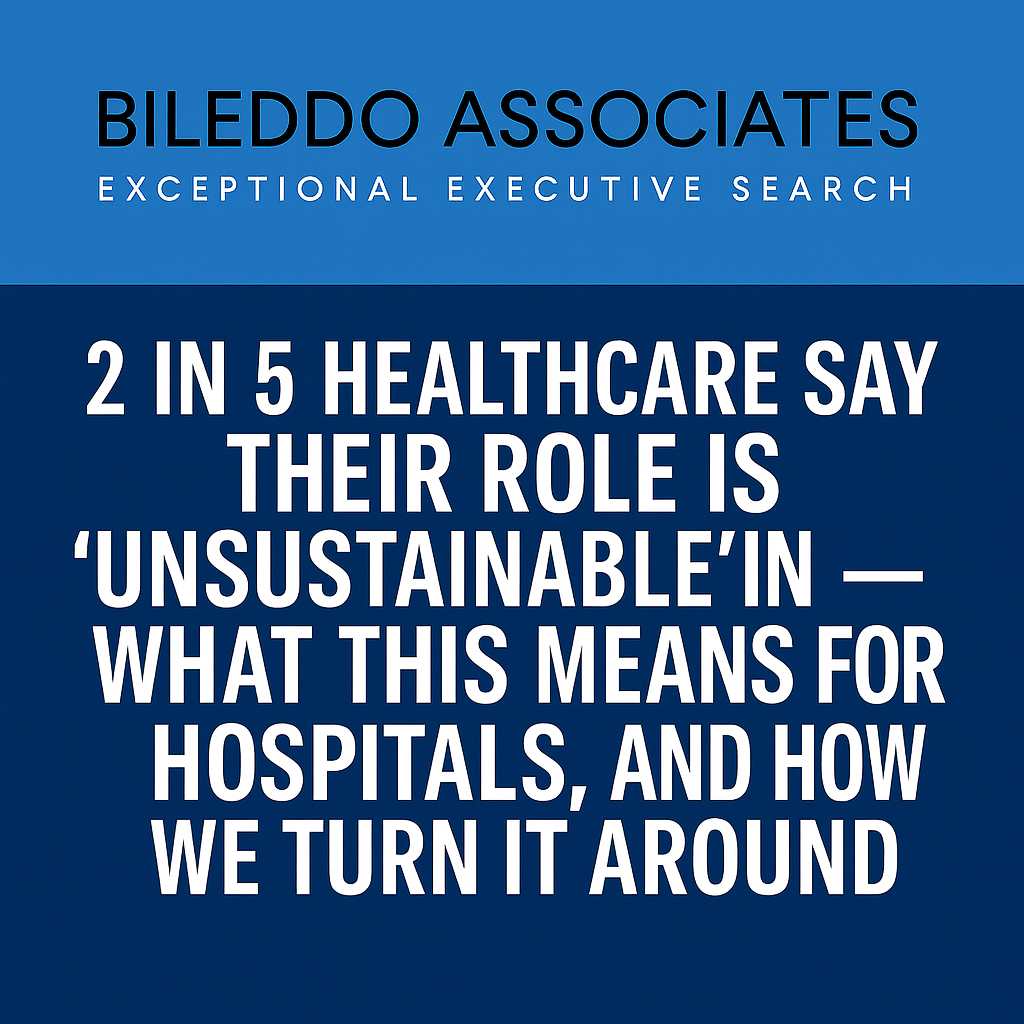
Healthcare is at an inflection point. According to Indeed’s Pulse of Healthcare 2025 report, 2 in 5 healthcare professionals feel their role is unsustainable, and 1 in 4 are actively considering leaving the industry.
That’s not a staffing problem — it’s a sustainability crisis.
When the people who hold the system together feel exhausted, detached, and unsupported, hospitals face a ripple effect: higher turnover, rising premium labor, operational slowdowns, and — most importantly — threats to patient safety.
But the data also reveals a path forward. And it starts with addressing the human needs inside every hospital.
What’s Driving the Crisis?
The report surfaces three key forces:
1. Burnout is overwhelming the system.
- 50% feel exhausted in their current role.
- 2 in 3 are unsatisfied with their job.
- 33% feel detached, and 36% feel negative about their work.
Burnout isn’t new — but the intensity and breadth of it are widening.
2. Well-being initiatives aren’t working.
A staggering 80% say their organization’s wellness efforts are ineffective.
And they’re telling us why:
- Staffing constraints limit participation (50%)
- Root causes of burnout aren’t being addressed (42%)
- Initiatives feel performative, not meaningful (41%)
- Programs aren’t tailored to frontline realities (35%)
Healthcare professionals don’t want another yoga class. They want bandwidth. Safety. Real support.
3. Dissatisfaction is rooted in fundamentals.
The top drivers of dissatisfaction are predictable — and solvable:
- Pay (40%)
- Staffing levels (36%)
- Career advancement (33%)
- Benefits (31%)
- Perceived commitment to employee well-being (27%)
This is not a “perk” problem. It’s an operational one.
What’s Still Working for Healthcare Workers?
Here’s where the data gives us hope.
Despite everything, the heart of healthcare is still the heart of the job:
- Relationships with patients (50%)
- Predictable work hours (41%)
- Supportive coworkers and managers (39%)
- Ability to take time off (36%)
- Schedule control (33%)
These are the anchors that keep people in the profession. Hospitals that strengthen these anchors win the long game.
What Hospitals Can Do Next (Practical Steps That Actually Help)
The good news? Healthcare workers are clear about what would help — and most of it is actionable.
Below is a roadmap to meaningful, high-ROI change.
1. Address Root Causes — Not Symptoms
Burnout isn’t solved by offering more programs. It’s solved by removing the conditions that cause burnout.
Start with:
- Staffing for workload, not just census
- Reducing nonessential administrative burden
- Streamlining EHR tasks with smart automation
- Eliminating “performative wellness” and building operational fixes instead
If it doesn’t reduce cognitive load or restore time, workers won’t feel relief.
2. Implement Real Staffing Solutions
42% say sustainable jobs require appropriate staffing levels.
- Build flexible float pools
- Use interim leaders to stabilize departments
- Reduce task overload with technology (67% say this would help)
- Ensure safe patient-to-provider ratios (61% want this)
These aren’t luxuries. They are backbone requirements for quality.
3. Make Employee Feedback Actionable
A powerful finding: 71% say acting on feedback — not just collecting it — would improve their work life.
That means:
- Closing the loop on feedback received
- Sharing what will be implemented and by when
- Assigning owners to make changes happen
Feedback without follow-through is worse than no feedback at all.
4. Strengthen Leadership Presence & Accountability
More than 80% say regular check-ins with leaders directly affect well-being.
Frontline teams thrive when leaders:
- Are visible
- Listen actively
- Understand the work firsthand
- Hold themselves accountable for creating supportive environments (59%)
- Are promoted internally when possible (52%)
People don’t leave jobs. They leave environments. Strong, engaged leadership changes everything.
5. Build Career Pathways That Actually Move
Healthcare workers cite career advancement (33%) as a top reason for dissatisfaction.
Hospitals can reverse this by:
- Creating transparent paths to promotion
- Offering specialization tracks and mentorship
- Developing nurse-to-leader and tech-to-supervisor pipelines
- Ensuring high performers aren’t overlooked due to understaffing
Growth is retention.
6. Protect Personal Time — Seriously
The report is blunt:
- 64% want zero nonemergency contact on off days
- 66% want mental health days separate from PTO
When people feel ownership over their personal time, they stay longer — and perform better.
The Path Forward: A More Sustainable Healthcare Workforce
The data is clear: Healthcare workers are not asking for luxuries. They’re asking for sustainability.
They want:
- Safe staffing
- Predictable schedules
- Leadership that listens
- Workloads that don’t feel crushing
- Real career opportunities
- Time to rest and disconnect
- Organizations that act, not admire the problem
If hospitals take these steps seriously, we not only retain the workforce we have — we rebuild trust, morale, and the future of care delivery.
How Bileddo Associates Helps Hospitals Move From Crisis to Stability
As hospitals face burnout-driven turnover and staffing fragility, our firm supports organizations by:
✔ Quickly stabilizing critical vacancies with interim and permanent leaders ✔ Identifying high-impact talent who elevate culture and retention ✔ Advising on structure, workload, and leadership models that reduce burnout ✔ Building bench strength so you’re never scrambling for a leader again
Hospitals don’t have to navigate this crisis alone — and they shouldn’t.
If you’re ready to strengthen your team and stabilize your workforce, let’s connect.
A more sustainable future for healthcare is possible. It starts with listening to workers — and acting decisively.
#HealthcareLeadership #HospitalStrategy #Recruiting #HealthcareTalent #HospitalSystems #BileddoAssociates
